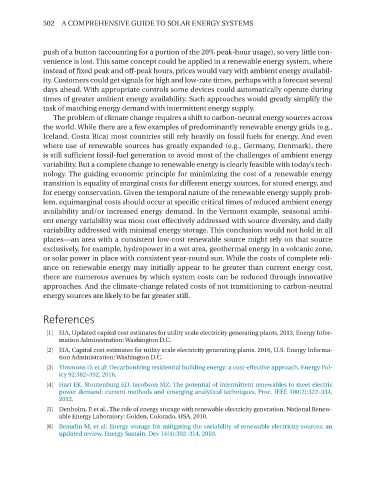Page 489 - A Comprehensive Guide to Solar Energy Systems
P. 489
502 A CoMPrEhEnsiVE GUidE To solAr EnErGy sysTEMs
push of a button (accounting for a portion of the 20% peak-hour usage), so very little con-
venience is lost. This same concept could be applied in a renewable energy system, where
instead of fixed peak and off-peak hours, prices would vary with ambient energy availabil-
ity. Customers could get signals for high and low-rate times, perhaps with a forecast several
days ahead. With appropriate controls some devices could automatically operate during
times of greater ambient energy availability. such approaches would greatly simplify the
task of matching energy demand with intermittent energy supply.
The problem of climate change requires a shift to carbon-neutral energy sources across
the world. While there are a few examples of predominantly renewable energy grids (e.g.,
iceland, Costa rica) most countries still rely heavily on fossil fuels for energy. And even
where use of renewable sources has greatly expanded (e.g., Germany, denmark), there
is still sufficient fossil-fuel generation to avoid most of the challenges of ambient energy
variability. But a complete change to renewable energy is clearly feasible with today’s tech-
nology. The guiding economic principle for minimizing the cost of a renewable energy
transition is equality of marginal costs for different energy sources, for stored energy, and
for energy conservation. Given the temporal nature of the renewable energy supply prob-
lem, equimarginal costs should occur at specific critical times of reduced ambient energy
availability and/or increased energy demand. in the Vermont example, seasonal ambi-
ent energy variability was most cost effectively addressed with source diversity, and daily
variability addressed with minimal energy storage. This conclusion would not hold in all
places—an area with a consistent low-cost renewable source might rely on that source
exclusively, for example, hydropower in a wet area, geothermal energy in a volcanic zone,
or solar power in place with consistent year-round sun. While the costs of complete reli-
ance on renewable energy may initially appear to be greater than current energy cost,
there are numerous avenues by which system costs can be reduced through innovative
approaches. And the climate-change related costs of not transitioning to carbon-neutral
energy sources are likely to be far greater still.
References
[1] EiA, Updated capital cost estimates for utility scale electricity generating plants. 2013, Energy infor-
mation Administration: Washington d.C.
[2] EiA, Capital cost estimates for utility scale electricity generating plants. 2016, U.s. Energy informa-
tion Administration: Washington d.C.
[3] Timmons d, et al: decarbonizing residential building energy: a cost-effective approach, Energy Pol-
icy 92:382–392, 2016.
[4] hart EK, stoutenburg Ed, Jacobson MZ: The potential of intermittent renewables to meet electric
power demand: current methods and emerging analytical techniques, Proc. iEEE 100(2):322–334,
2012.
[5] denholm, P. et al., The role of energy storage with renewable electricity generation. national renew-
able Energy laboratory: Golden, Colorado, UsA, 2010.
[6] Beaudin M, et al: Energy storage for mitigating the variability of renewable electricity sources: an
updated review, Energy sustain. dev 14(4):302–314, 2010.

